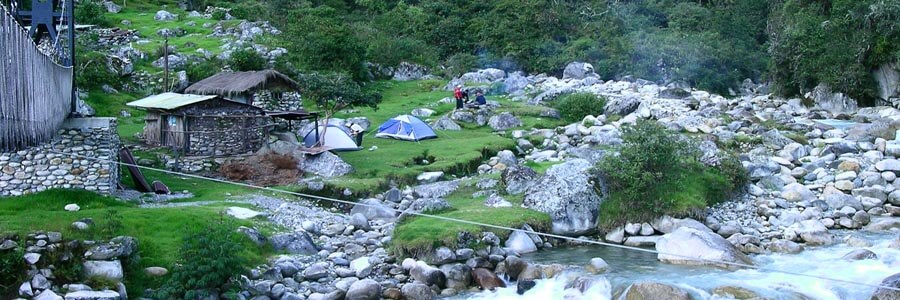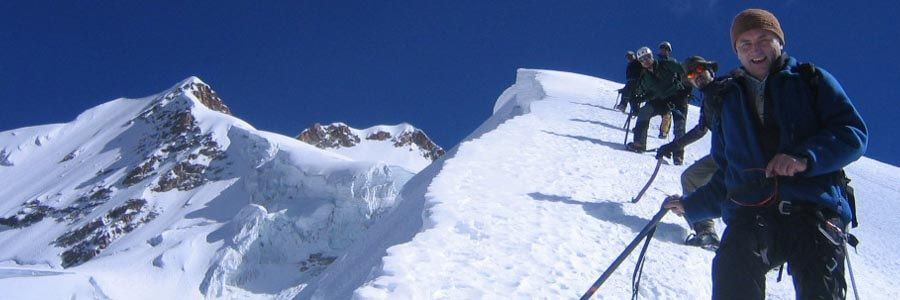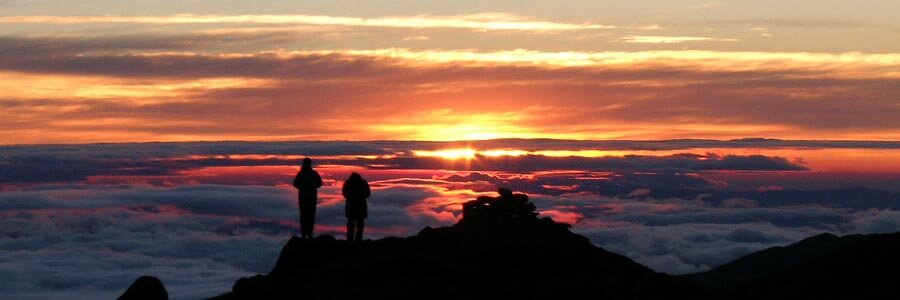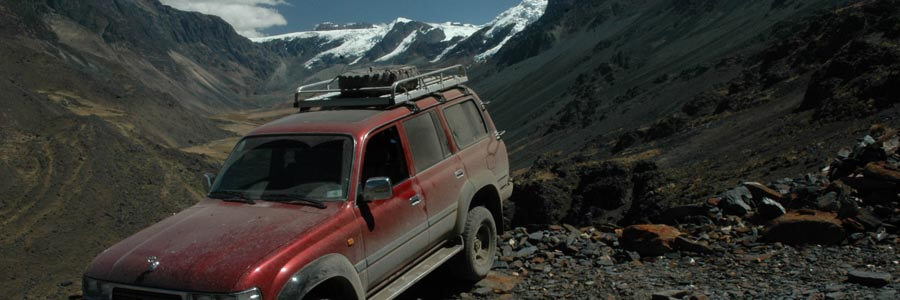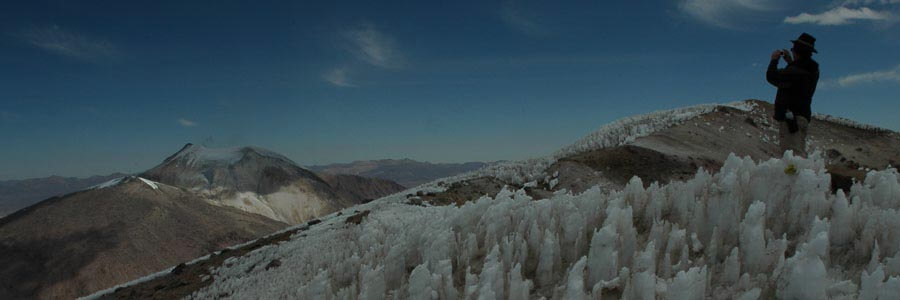General information
Location
Chile is a long and narrow piece of land at the West coast of South America, as long as 4,.300km (2,671mi) and no wider than 200km (124mi), has an extension of 756,946 km2. In South America only Uruguay, Paraguay and Ecuador have less territory than Chile.
Its borders are: to the North with Peru, to the Northeast with Bolivia, to the East with Argentina, and to the West with the Pacific Ocean. Some of its most impressive attractions are the volcanic sections of the Andes, they are located along to the eastern border shared with Bolivia and Argentina, the summits of these volcanoes make a natural landmark for the border line, and can be accessed either side. The northern Chile where the Atacama is located,is very desertic. The center where Santiago de Chile is located is composed by fertile valleys trappedbetween the Andes and the Coast range. Tierra del fuego to the South is a complex land of fiords, islands and hundreds of lakes surrounding a heavily forested land. Chile owns part of the Antarctic continent.
Country size
Long as 4,.300km (2,671mi) and no wider than 200km (124mi) has an extension of 756,946 km2
Population
Its population of almost 16 million inhabitants (July 2002 est.)
Capital
Santiago de Chile
Major religion
Roman Catholics in Chile are the 81%; the rest is protestant with a very small group of native religions
Major languages
Official language in Chile is Spanish.
Economy
Mining and agriculture are the base of the Chilean economy, The biggest underground copper mine in the world “El Teniente” is in Chile, and Close to Calama is also Chuquicamata, the biggest open air copper mine in the world.
About agriculture, thanks to the waters from the mountains of the Andes, Chile produces wheat, potatoes, corn, rice, tomatoes, oats and Fruit. Fishing is another important activity in the long coastal side of Chile.
Monetary unit
Peso Chileno
International dialing code
Country code (56).
Internet domain
.cl
Anecdotic information
- In relation with its area 756.945 km² (295.208 mi²), iIt is the country with the longest coast line 6.435 km (3.996 mi).
- The highest active volcano on earth, Ojos del Salado, 6,870m (22,533ft). It is also the second highest peak of the Americas.
- The highest archeological ruins on earth at the Summit of Volcano Llullaillaco at 6,739m (22,103ft) there are small buildings which were the tombs of three Inca children sacrificed more than 500 years ago.
- The biggest open air mines on the planet: Chuquicamata and Collahuasi Copper mines.
- The smallest precipitation rate on earth, Atacama desert with less than 200mm/year.
- The greatest concentration of volcanoes (cones, peaks and mountains) near the Atacama desert.
- Biggest copper exporter with the 34,7% of the world’s production.
- The southernmost town on the planet is Puerto Williams, close to 55° Latitude South.
- The southernmost point of the continent, Cabo de Hornos.
- The southernmost 6000er in the planet: Marmolejo 6,108m (20,034ft).
- The biggest ice capes of the continent are in southern Patagonia.
- Chile was the last country in South America to have a divorce law.
- Chile is the first minerals exporter of Latin America. It’s main mineral is copper with a production 3691 million tons a year. It is the first copper exporter of the world.
- Chile has the largest portion of the Andes, 6.011 km (3.733 mi.) north to south line.
- Is the fist country in the Americas to elect a women as a president.
- In relation with its area 756.945 km² (295.208 mi²), iIt is the country with the longest coast line 6.435 km (3.996 mi).
- The highest active volcano on earth, Ojos del Salado, 6,870m (22,533ft). It is also the second highest peak of the Americas.
- The highest archeological ruins on earth at the Summit of Volcano Llullaillaco at 6,739m (22,103ft) there are small buildings which were the tombs of three Inca children sacrificed more than 500 years ago.
- The biggest open air mines on the planet: Chuquicamata and Collahuasi Copper mines.
- The smallest precipitation rate on earth, Atacama desert with less than 200mm/year.
- The greatest concentration of volcanoes (cones, peaks and mountains) near the Atacama desert.
- Biggest copper exporter with the 34,7% of the world’s production.
- The southernmost town on the planet is Puerto Williams, close to 55° Latitude South.
- The southernmost point of the continent, Cabo de Hornos.
- The southernmost 6000er in the planet: Marmolejo 6,108m (20,034ft).
- The biggest ice capes of the continent are in southern Patagonia.
- Chile was the last country in South America to have a divorce law.
- Chile is the first minerals exporter of Latin America. It’s main mineral is copper with a production 3691 million tons a year. It is the first copper exporter of the world.
- Chile has the largest portion of the Andes, 6.011 km (3.733 mi.) north to south line.
- Is the fist country in the Americas to elect a women as a president.
How to get there
Chile has several international airports. The most important ones are in the cities of Santiago, Punta Arenas, Arica, Calama and Iquique. Most major airlines have daily flights into Santiago’s airport from most major cities in the Americas and Europe.
By Land you can take one of the following entry points:
- From Peru: by the Pan-American highway from Lima, Cuzco, Arequipa or Tacna.
- From Bolivia: by the international highways from La Paz and Oruro, or by taking an international transportation by the Uyuni Salt lake.
- From Argentina: by several international highways that connect different cities in both countries.
Documentation
Passports (*) are required to enter Chile . Usually, hotels, banks, Money exchange houses, Post offices, and airports will ask proof of passport too.
Contact the local Chilean consulate or embassy for more information on proper entry requirements (visa) since they vary depending on your nationality.
American and most of the European countries citizens do not need visa to enter Chile while traveling as tourists
As a thumb of rule Chile grants a 30-day free visa upon entry to the country. You can obtain an extension of 30, 60 up to 90 days depending on your nationality and proper paper work. Working and study visas can also be obtained fulfilling the requirements.
Tourists coming from a country where Yellow Fever is a risk (part of Africa, Central America and Caribbean) must show legal evidence of an up-to-date vaccine.
(*) When booking a Andean Summits trip, you have to provide us a photocopy of your passport and the “form” you get when entering into the country.
Safety & Dangers
Since 1989, Chile has had a Democratic system, the political situation has been very stable and the economy has grown without precedent. The Democratic system is now deeply rooted into peoples minds.
As any other countries, chile has not solved all its social and economic problems. That causes some protests against the government. Demonstrations are relatively seldom, normally peaceful and usually disappear in a short time.
Most of the roads and paths in the cities and villages (with the exception of some big city suburbs) are safe for tourist traveling. Carrying a backpack and other valuables does not necessarily pose a threat for assault. Generally speaking Chileans are very amiable and generous.
Chile is quite peaceful, safe and hospitable. Terrorism is not part of this society and extreme crimes are not the rule, but the exception.
Since there are some “pickpockets” and "scammers" on the streets, we recommend that you carry your money, airline ticket, and passport in a belt or in a small travel bag which you can hang around your neck. We suggest that you leave your jewelry and other valuables at home or deposit them in a security box at the hotel.
Although very tough and sometimes extremely burocratic, Chilean police force called "Carabineros" are fully trustable. You can count on them.
If you are planning to travel independently, we advise the following:
Almost all of the trails are unmarked.
- Current detailed maps of 1:50,000 scales are available in Santiago.
- The tourist offices have plenty of accurate information. There is at least one information office in every major city.
- Even though the local people are quite friendly, we suggest that you keep your campsite at a respectable distance from the villages, especially during “fiestas”.
- There is a formal Mountain Rescue System in the country but operates close to Santiago only, For the rest of the country expect to be on your own. You should have both air-evacuation and medical insurances.
Money Topics
All banks change Dollars and Euros. There are also "Exchange bureaus" in most cities but before trying one you should ask the police for the proper ones. It is almost impossible to pay anything with dollars or euros, most people on businesses or shops will not accept them.
Credit cards such as: Master Card, Visa, and American Express are accepted in hotels, restaurants, and some stores. You can also get cash from them in most of the banks and cashier machines. Local commission varies from 1% to 3%.
Traveler’s checks such as: American Express, Visa, Thomas Cook, Citibank, and Bank of America are accepted in banks and money exchange houses (very few stores will accept traveler’s checks). Do not sign them until the payment and make a photocopy of them in case you loose them. Local commission varies from 1 to 3 %.
It is recommended to carry your money, airline ticket, and passport in a belt or in a small travel bag, which you can hang around your neck. We recommend that you leave your jewelry and other valuables at home or deposit them in a security box at the hotel.
Communications
The Pan American Highway runs almost all the way From North to South; only the regions in the South composed by islands and archipelagoes are better reached by plane. International entrances are many harbors in the Pacific, The Road Arica Tacna to Peru, Arica Chungara, Iquique Colchane, San Pedro de Atacama hito cajones to Bolivia, and the international road from Santiago to Mendoza in Argentina, International airports are found in Santiago Iquique and Arica.



